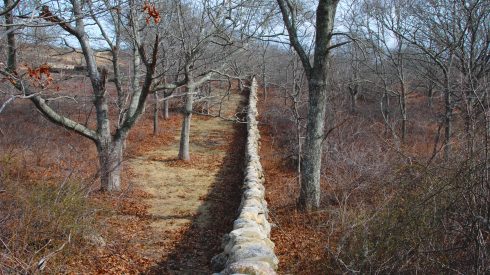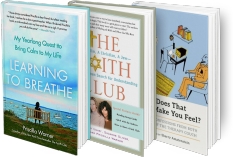
My Path From Panic to Peace
When I was fifteen years old, I suffered my first panic attack, behind the grease-splattered stainless steel serving counters of the Brown University cafeteria in Providence, Rhode Island, where I was a waitress.
One minute I was dishing out peas to hordes of bored young students, and then I almost died.
Not really.
But my heart raced and flopped around in my chest, my lungs starting convulsing, I turned hot and cold, shaking head to toe, and my throat began to close. I tried to take a deep breath and I couldn’t.
Was I really dying? I wasn’t sure.
Was I going crazy? That was possible.
Mental illness ran through my family like wildfire. My father had been diagnosed as manic depressive, his twin brother was in and out of mental hospitals all his life, and my namesake, a favorite cousin, grew up to become a homeless schizophrenic.
So I thought mental illness was contagious.
And my fear was confirmed when I rushed home from work and a family doctor was called to our house. He diagnosed me as being “a little bit nervous,” and prescribed Librium, the tranquilizer taken mostly by American housewives more than twice my age in the 1960s.
The word “panic attack” wasn’t even used back then, so I thought I was a freak. “Anxiety” wasn’t a term that girls my age had ever heard of.
I managed to hide my embarrassing condition from even my closest friends, while carrying a flask of vodka with me everywhere. Not to get drunk, but to tell myself that if I took a swig, the fiery liquid would tamp down the anxiety coursing through my veins.
A therapist switched my medication to Valium, and yet I continued having panic attacks. Over and over again, for the next forty years, I suffered hundreds of them – at school, at various advertising agencies where I worked, in crowded movie theaters, on New York City buses and subways, and while on vacation at the beach.
I was functioning fine on the outside – as a productive professional, a wife in love with her understanding husband, and the mother of two beautiful sons. But after the attacks of 9/11, my panic attacks increased in frequency. I was living in a city that felt like it was under siege, and that was a feeling I knew all too well – I had always felt as though my body was under siege.
I found a psychchiatrist who helped me talk about my anxiety in a new, more comprehensive way. She switched my medication to Klonopin, which seemed to be more effective.
And I met two women struggling with the religious and political issues brought to the forefront of American culture after 9/11. We wrote a book detailing our intense, honest interfaith conversations, but when it became a huge bestseller, and we traveled the country speaking to thousands of people in churches, synagogues and mosques, my anxiety increased. I felt like a bit of a fraud as I appeared on radio and tv talking about my spiritual breakthroughs while my anxiety was still ever-present.
I had no idea that six million other Americans were suffering from a panic disorder, that forty million were battling an anxiety disorder of some kind.
But one person in particular, a young Tibetan monk named Yongey Mingyur Rinpoche, did catch my attention. He’d suffered panic attacks as a child, which he’d cured through his meditation practice. Neuroscientists were using the term brain plasticity to describe how people of any age can change the way their brains operate. Scientists were studying the brains of Tibetan monks like Yongey Mingyur Rinpoche, to determine how meditation actually helped do that.
I wanted the brain of a monk, and everything that went along with that brain – like peace and tranquility. And – dare I wish for this – true happiness.
So I wrote a proposal for a memoir called Learning to Breathe, describing how I wanted to transform myself from a neurotic Jew to a serene Tibetan monk. “Forget ‘Physician Heal Thyself’” I joked. My new mantra would be ‘Neurotic, heal thyself. And please stop complaining!
But could I actually do that?
I sold my book proposal and then I began researching meditation teachers and resources, hoping to design my own holistic healing experiment.
I signed up for a five-day silent retreat with Yongey Mingyur Rinpoche. Along with 100 other students, staying in an old monastery, I learned how to meditate, and he advised me to look at myself as a horse and rider. “Your body is the horse,” he said. “It needs exercise, yoga, sleep and the proper nutrition. Your brain is the rider, and what it needs is meditation.”
I vowed to meditate every day, and in a few weeks I began to see results. My husband noticed that my quick temper was gone for the most part. Friends said my face looked more relaxed and that I seemed calmer. I didn’t react to upsetting experiences quite as quickly or as vocally.
After a few months of meditating, I found a therapist who used techniques called Somatic Experiencing and EMDR to help me reprocess disturbing memories of a childhood trauma I’d stored deep in my body. I managed to discharge the frightening physiological sensations that had been precursors to my panic attacks.
A wonderful Buddhist teacher named Sharon Salzberg taught me a technique called metta, or loving-kindness meditation. A neuroscientist named Andrew Newberg scanned my brain before I began that practice, and then again eight weeks later. He confirmed what I knew: my scans showed increased blood flow to certain parts of my brain, which illustrated a powerful training effect. Meditation is like lifting weights for the brain, according to this neuroscientist, and I felt like a bulked up musclewoman.
I began to feel a happiness I could never have imagined. My panic attacks became fewer and farther between. I cut back my dose of anti-anxiety medication slowly, until I was taking it only occasionally. My life did not turn into a perfect fairy tale; my suffering and the suffering of people I loved continued. Difficult life events unfolded for me and my loved ones.
And then who could have ever predicted a worldwide pandemic that would force billions of people to confront their worst fears while feeling so much grief, anger and loss?
But that’s what keeps me grounded now – the realization that I am not alone in my suffering. “The whole world is catching up with you,” someone told me recently. The ground underneath every single human being has shifted. And the tools I’ve learned for coping with anxiety, fear and panic are still universally applicable.
There are so many ways to heal our broken hearts and battered minds. There are so many teachers and healers who’ve dedicated their lives to alleviating the suffering of others. I follow them online and meditate with them in virtual sanghas, or meditation groups. I try to find and learn from people who act out of compassion in every facet of their lives, whether they’re doctors, nurses, or people distributing food in communities battered by this health and economic crisis.
There’s less stigma about anxiety and depression now that we are all more aware of our mortality and vulnerability.
I no longer feel alone or ashamed.
Because we are all learning how to breathe.
